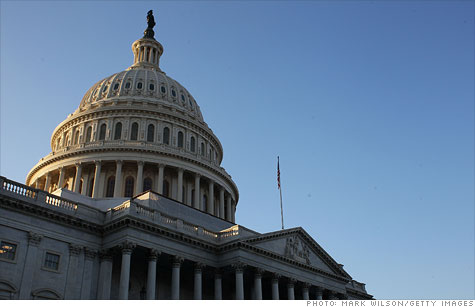Search News

All the partisan yelling on Capitol HIll about spending rarely touches on what budget experts call "hidden spending" through the tax code.
NEW YORK (CNNMoney) -- Which costs the federal government more: a $2,100 check from Uncle Sam or a tax break worth $2,100?
The answer is they cost the same.
The difference is that the $2,100 check is classified as federal spending. And the tax break doesn't show up on the $3.6 trillion federal budget.
When politicians and others talk about the size of government and how to lower deficits, it's as if tax breaks don't exist.
But fiscal experts believe many tax breaks should be counted as spending.
After all, by handing out those tax breaks, the government is giving up hundreds of billions of dollars in revenue.
And in terms of policymaking, many tax breaks are the functional equivalent of cash. That is, the government uses them to achieve goals that could just as easily be achieved by issuing a check.
Examples abound. Congress wants to foster homeownership, so it lets homeowners deduct their mortgage interest. Lawmakers want to reduce greenhouse gas emissions, so they offer a tax credit to companies that produce biofuels such as ethanol or biodiesel.
The issue of so-called tax expenditures is of great importance today, as politicians and presidential candidates debate how to control government spending, which is a measure of how big government is.
"We should think carefully about how to measure it," said Donald Marron, director of the Tax Policy Center.
Indeed, if tax breaks that are "clear spending substitutes" were counted as spending, government would make up a much bigger share of the economy than is typically reported, Marron and center co-director Eric Toder conclude in a new report.
"Doing so raises measures of both spending and revenues without affecting the deficit and gives a different picture of the economic resources that the government directs," Marron and Toder write.
So, in 2007, for example, the government was officially reported to have spent 19.6% of gross domestic product. But when spending-like tax breaks are added in, the number jumps to 23.7%.
And tax breaks aren't the only things that go uncounted.
User fees and other "offsetting receipts" that come in to the government, such as Medicare premiums, are simply used to reduce reported government spending. They're not actually counted as a revenue source, which is effectively what they are.
In all, if they were also recategorized in the budget, government spending in 2007 would have to be reported as 25.4% of GDP -- or a nearly a third more than advertised.
So what would be the value of all this re-jiggering? For one thing, it would help change the conversation about deficit reduction and tax reform. Policymakers could gain a fresh perspective on how much the government spends -- both directly and through the tax code.
Independent deficit experts have been saying until they're blue in the face that it's not feasible to bring U.S. debt under control in the long run through spending cuts alone, given the aging of the population and rising health care costs.
But by recognizing the spending done through the tax code, policymakers would have more options when they look for places to cut spending.
And that could also ease concerns of policymakers who don't want to raise tax rates.
By curbing various tax breaks that are essentially spending substitutes, Congress can raise new revenue without raising rates and indeed may even be able to lower rates, Marron noted in an earlier paper on the issue.
A full-blown debate about tax expenditures would also give lawmakers an opportunity to do what they rarely do -- evaluate the effectiveness of the tax breaks on the books. Typically, once a tax break passes, it's rarely scrutinized again.
"[H]idden spending should get the same scrutiny -- and inspire the same enthusiasm for cuts -- as the spending on entitlements, domestic programs, and defense that is targeted by today's fiscal hawks," Marron wrote. ![]()
| Overnight Avg Rate | Latest | Change | Last Week |
|---|---|---|---|
| 30 yr fixed | 3.80% | 3.88% | |
| 15 yr fixed | 3.20% | 3.23% | |
| 5/1 ARM | 3.84% | 3.88% | |
| 30 yr refi | 3.82% | 3.93% | |
| 15 yr refi | 3.20% | 3.23% |
Today's featured rates:
| Latest Report | Next Update |
|---|---|
| Home prices | Aug 28 |
| Consumer confidence | Aug 28 |
| GDP | Aug 29 |
| Manufacturing (ISM) | Sept 4 |
| Jobs | Sept 7 |
| Inflation (CPI) | Sept 14 |
| Retail sales | Sept 14 |